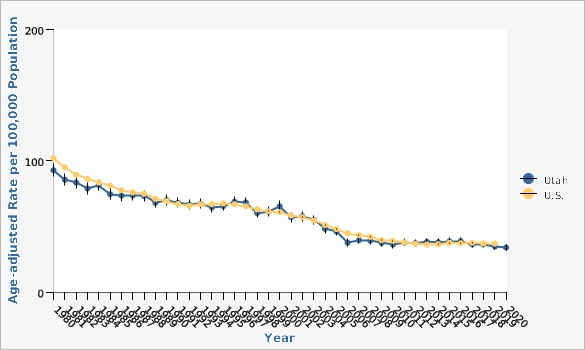PHOM Indicator Profile Report of Stroke (Cerebrovascular Disease) Deaths
Why Is This Important?
In the U.S., there are more than 140,000 deaths due to stroke each year ([https://www.cdc.gov/stroke/facts.htm]). Stroke, the death of brain tissue usually resulting from artery blockage, was the sixth leading cause of death in Utah in 2020. There were 916 deaths with stroke as the underlying cause of death in the state.Stroke deaths have had an overall slow but steady decline for both Utah and the U.S. In 2019, the age-adjusted stroke death rate for Utah was 34.7 per 100,000. The age-adjusted U.S. rate for 2019 was 37.0 per 100,000 (U.S. rates for 2020 were not available at the time of publication).
Data Sources
- Utah Death Certificate Database, Office of Vital Records and Statistics, Utah Department of Health
- Population Estimates: Utah Governor's Office of Planning and Budget
- Population Estimates: National Center for Health Statistics (NCHS) through a collaborative agreement with the U.S. Census Bureau, IBIS Version 2018
- U.S. Centers for Disease Control and Prevention, on-line data - CDC WONDER
- National Vital Statistics System, National Center for Health Statistics, U.S. Centers for Disease Control and Prevention
Data Notes
ICD-9 codes 430-438; ICD-10 codes I60-I69 (equivalent to NCHS 113 Leading Causes of Death #61: Cerebrovascular Diseases). Estimates from 1998 and before have been comparability-modified to be consistent with ICD-10 coding system definitions. All rates are age-adjusted to the U.S. 2000 standard population. However, Utah rates are drawn from IBIS, which uses 11 age-adjustment groups, and may differ from the Utah rates in CDC WONDER. ICD-10 codes used were I60-I69.Risk Factors
Risk factors for stroke include high blood pressure, increasing age, family history of stroke, personal history of stroke, cigarette smoking, diabetes, heart disease, carotid artery disease, transient ischemic attacks, and a high red blood cell count. Elevated cholesterol level, obesity, and lack of physical activity increase the risk of stroke. Many of these risk factors can be modified successfully by adopting lifestyle changes.[[br]] [[br]] ---- American Heart Association. ''What are the risk factors of stroke?'' Accessed at [http://www.strokeassociation.org/STROKEORG/AboutStroke/UnderstandingRisk/Understanding-Stroke-Risk_UCM_308539_SubHomePage.jsp].[[br]]How Are We Doing?
Utah is getting closer to its target of reducing stroke deaths to 28.2 per 100,000 population. Death rates for stroke have generally declined in recent decades. This trend is likely related to improvements in acute stroke care and in improved detection and treatment of hypertension, a risk factor for stroke. In 1999 (the year ICD-10 codes were adopted for death coding), the age-adjusted death rate for stroke in Utah was 61.3 per 100,000 population. In 2020, the age-adjusted death rate was 34.0 per 100,000 population.What Is Being Done?
Originally the EPICC Program (The Healthy Living through Environment, Policy, and Improved Clinical Care Program), The Healthy Environments, Active Living (HEAL) Program was formed in 2013, consolidating three Utah Department of Health programs (Diabetes Prevention and Control Program, Heart Disease and Stroke Prevention Program, and the Physical Activity, Nutrition, and Obesity Program). The purpose of the consolidation was to ensure a productive, collaborative, and efficient program focused on health outcomes. The HEAL Program aims to reduce the incidence of diabetes, heart disease, and stroke by targeting risk factors including reducing obesity, increasing physical activity and nutritious food consumption, and improving diabetes and hypertension control.Healthy People Objective: Reduce stroke deaths
U.S. Target: 34.8 deaths per 100,000 populationState Target: 28.2 deaths per 100,000 population

